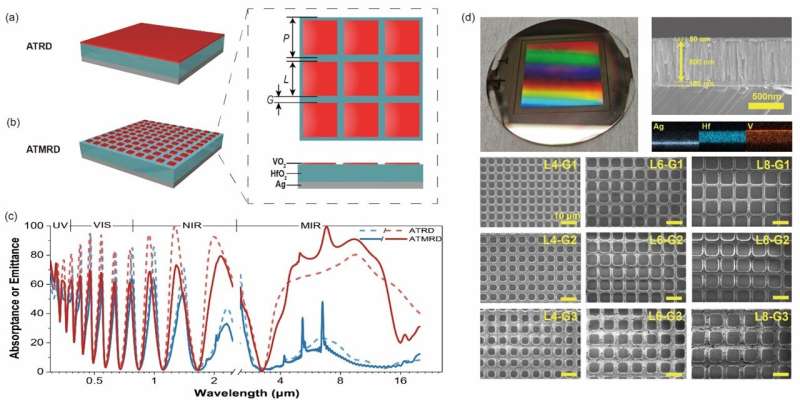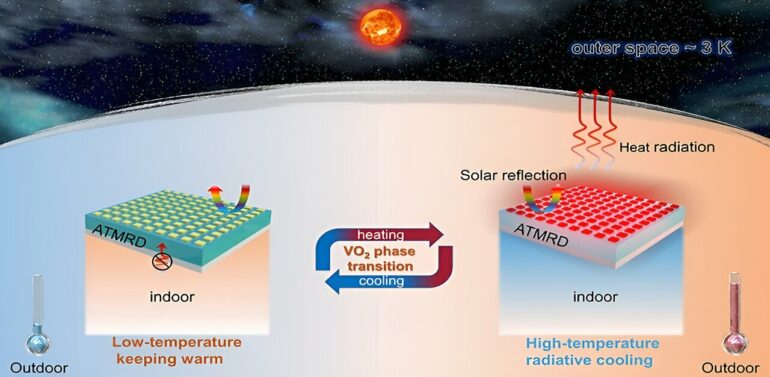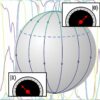As the global energy crisis intensifies and climate change accelerates, finding sustainable solutions for energy management is increasingly urgent. One promising approach is passive radiative cooling, a technology that allows objects to cool by emitting heat directly into space, requiring no additional energy.
Radiative cooling materials should exhibit high solar reflectivity and emissivity performance. A variety of radiative cooling materials have been developed yet most of them have static emissivity. This means that when the ambient temperature is low, the radiative cooling materials still have a strong cooling capacity, resulting in “overcooling,” which increases the energy consumption of the heating system. On the other hand, thermochromic phase-change materials are ideal candidates for dynamic radiative cooling. No power source, circuits, or moving parts required.
Researchers at the Beijing Institute of Technology recently made significant strides in this direction. As reported in Advanced Photonics, they developed a new type of temperature-adaptive radiative cooling device that dynamically adjusts its cooling properties based on the surrounding temperature.
This advancement builds on previous work with vanadium dioxide (VO2), a material known for its ability to switch between different thermal radiation states. The new design features a metasurface with a periodic array of VO2 squares, which improves the device’s performance by balancing high thermal emissivity with low solar absorptance.
The new device, termed the Temperature-Adaptive Metasurface Radiative Cooling Device (ATMRD), shows notable improvements over previous designs. It has a solar absorptance of just 27.71%—which is 7.54% lower than earlier models—and an emissivity of 0.85 at high temperatures—which is 13.3% higher. Additionally, its ability to modulate emissivity is 20% better than previous devices, making it more efficient at managing temperature changes.

Schematic diagram of temperature-adaptive metasurface radiative cooling device. (a) Typical F-P structure radiation temperature control device, (b) Designed superstructure radiation temperature control device. (c) Comparison of simulated solar absorptance and thermal emissivity between ATRD and ATMRD. The blue line represents low temperature, and the red line represents high temperature. (d) Fabricated ATMRDs. © J. Yang et al., doi 10.1117/1.AP.6.4.046006.
“By integrating a temperature-adaptive metasurface with vanadium dioxide, we’ve significantly improved the efficiency of radiative cooling technologies. Our new device not only reduces solar absorptance but also enhances thermal emissivity, addressing the critical issue of overcooling. This advancement holds great promise for optimizing energy use and advancing sustainable thermal management solutions,” said lead researcher Prof. Jingbo Li.
This work clarifies how the geometric parameters of the superstructure influence the device performance and reveals the mechanism of enhanced thermal radiation performance through superstructure-excited multiple resonances. The reported research offers valuable theoretical and practical references for designing and developing VO2 superstructure functional devices, with the potential to significantly impact the fields of thermal management and renewable energy.
Highlighting the potential of advanced materials and design techniques to enhance radiative cooling technologies, the insights gained could lead to more effective thermal management solutions, contributing to energy savings and a more sustainable future.
More information:
Junlin Yang et al, Temperature-adaptive metasurface radiative cooling device with excellent emittance and low solar absorptance for dynamic thermal regulation, Advanced Photonics (2024). DOI: 10.1117/1.AP.6.4.046006
Citation:
Novel metasurface enables temperature-adaptive radiative cooling (2024, September 5)



